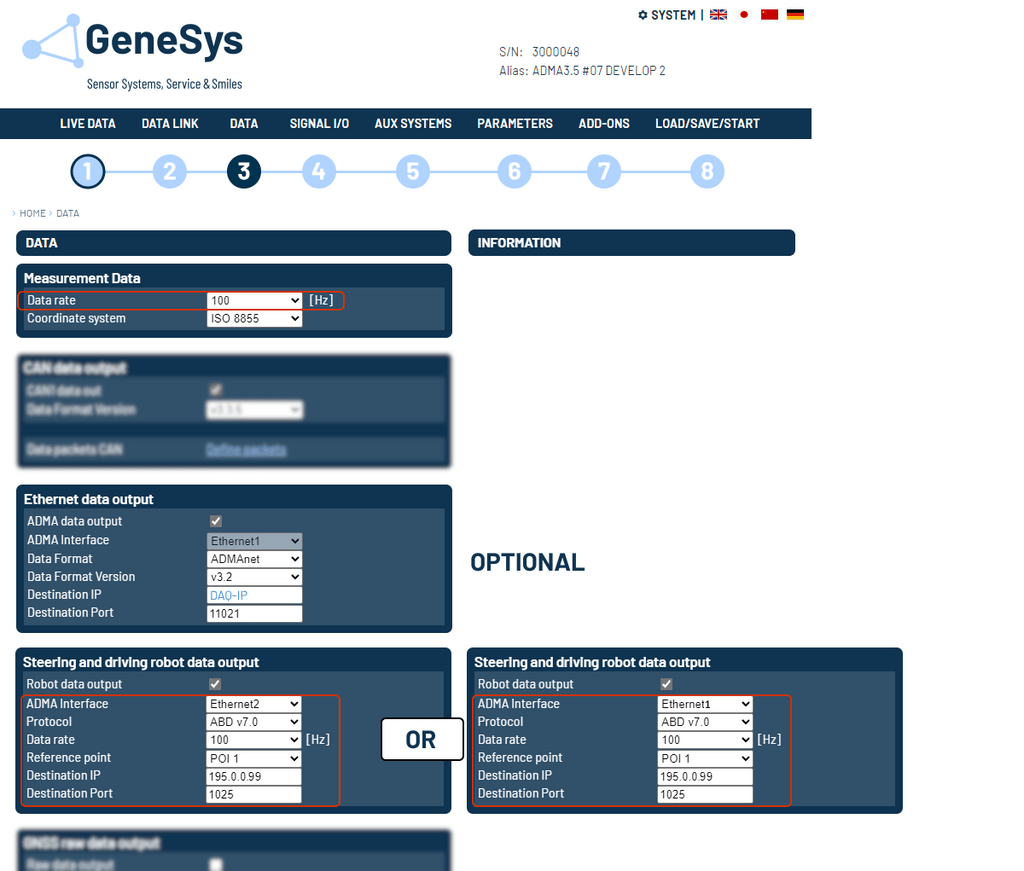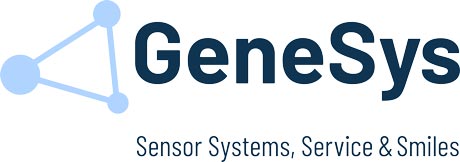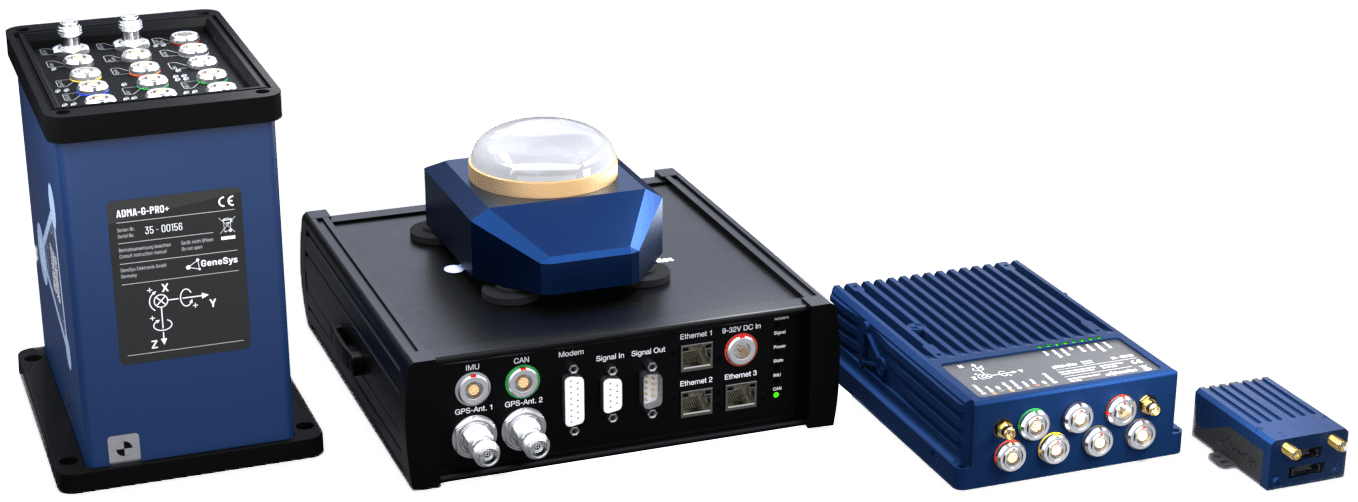This manual shows the ADMA configuration that is needed for the integration in ABD LP-Spin. Both PMAC Types, Power PMAC and Turbo PMAC are explained.

Confidentiality
All information within this document is strictly confidential and must not be passed to 3rd parties without the prior consent of GeneSys Elektronik GmbH.
Connect to the ADMA Web Interface
For connecting to the ADMA web interface for the first time, please type in the following IP-address into the browser.
Default (Fallback) IP-Address: 192.168.88.30
Default Subnet mask: 255.255.255.0
Configuration of the ADMA
Different PMAC systems are used. In the past AB Dynamics used the Turbo PMAC, but in current ABD systems Power PMAC is integrated. For this reason, the IP settings are separated in the following.
For checking which PMAC system is integrated in your device, just check the subnet mask scheme of your ABD devices.
| 255.255.255.0 | ➜ | Turbo PMAC (Legacy) |
| 255.255.0.0 | ➜ | Power PMAC (Current Standard) |
Power PMAC
Data Link
Configure the ADMA IP-address and the subnet mask to ABD standard:
Ethernet 1 OR Ethernet 2
| IP-Address: | 195.0.X.6 |
| Subnet mask: | 255.255.0.0 |
X: Vehicle ID

Data
Configure the data rate, Coordinate System and the ethernet data output settings as below:
| Data rate: | 100 |
| ADMA-Interface: | ETH1 OR ETH2 |
| Destination IP: | 195.0.X.3 |
| Destination Port: | 1025 |
| Protocol: | From RC and Power PMAC Version 8.15.x protocol ABD v7.0 have to be used |
X: Vehicle ID (E.g. Vehicle no. 5 ➜ 195.0.5.3)

Aux Systems
There are different opportunities to receive correction data with the ADMA.
Note: GeneSys and AB Dynamics recommend to use broadcasts only if needed. The more broadcasts in the network, the higher the risk of overload. If possible, send the correction data streams from the key switch box directly to each ADMA system.
GNSS Base Station broadcast
The GNSS Base station can send the correction data via broadcast directly into the network. In this case, the GNSS Base Station can be installed besides the WiFi Mesh and gets connected to it. Configure the DGNSS options in the ADMA Webinterface as below:
| DGNSS Preset: | ADMA – Ethernet |
| IP-Address: | IP-Adress of Base station |
| Subnet mask: | 255.255.0.0 |
Satel Radio modem
A Satel Radio modem can be connected directly to the ADMA. Configure the DGNSS options as below:
| DGNSS Preset: | GeneSys BASE – Radio Modem |
| Baud rate: | 9600 / 19200 (depending on base station settings) |
RS232-Converter-Box / Key-Switch-Box / Driverless Base station safety control – Broadcast
Key-Switch-Box sends correction data via broadcast.
| Source IP | 105.0.Y.208 (IP-Address of Key Switch Box) |
| Source Port | 5010 |
RS232-Converter-Box / Key-Switch-Box / Driverless Base station safety control – Direct IP
Key-Switch-Box sends correction data directly to the ADMA IP-address.
| Source IP | 105.0.Y.208 (IP-Address of Key Switch Box) |
| Source Port | 3030 |
Y: Base Station ID

Parameter
Configure the System Parameters as below:
| Min. velocity for AutoInit: | 1 |
| Min. velocity for heading ctrl: | 1 |
| Max. rate at standstill: | 5 |
| Max. velocity at standstill: | 5 |
| Application | VRU-Target |
| Vehicle Model | Off |

Configure the Mounting offsets as following:
| X | Y | Z | |
|---|---|---|---|
| Mounting offset angle | 180 | 0 | 180 |
| Mounting Offsets Primary GNSS Antenna to ADMA – internal antenna | 21 | 28 | 5 |
| Virtual Measurement Point (POI1) | -12.5 | 17 | 0 |

Save the settings to the ADMA and start the measurement.

Turbo PMAC
Data Link
Configure the ADMA IP-address and the subnet mask to ABD standard:
Ethernet 1 OR Ethernet 2
| IP-Address: | 195.0.0.132 |
| Subnet mask: | 255.255.255.0 |

Data
Configure the data rate, Coordinate System and the ethernet data output settings as below:
| Data rate: | 100 |
| ADMA-Interface: | ETH1 OR ETH2 |
| Destination IP: | 195.0.0.99 |
| Destination Port: | 1025 |
| Protocol: | From RC and Power PMAC Version 8.15.x protocol ABD v7.0 have to be used |
In some cases the Destination IP 191.0.0.100 and 195.0.0.101 are used. In this case the IP-Address of the ADMA at menu 2-Data link must be adapted to the same network.

Aux Systems
There are different opportunities to receive correction data with the ADMA.
Note: GeneSys and AB Dynamics recommend to use broadcasts only if needed. The more broadcasts in the network, the higher the risk of overload. If possible, send the correction data streams from the key switch box directly to each ADMA system.
GNSS Base Station broadcast
The GNSS Base station can send the correction data via broadcast directly into the network. In this case, the GNSS Base Station can be installed besides the WiFi Mesh and gets connected to it. Configure the DGNSS options in the ADMA Webinterface as below:
| DGNSS Preset: | ADMA – Ethernet |
| IP-Address: | IP-Adress of Base station |
| Subnet mask: | 255.255.0.0 |
Satel Radio modem
A Satel Radio modem can be connected directly to the ADMA. Configure the DGNSS options as below:
| DGNSS Preset: | GeneSys BASE – Radio Modem |
| Baud rate: | 9600 / 19200 (depending on base station settings) |
RS232-Converter-Box / Key-Switch-Box / Driverless Base station safety control – Broadcast
Key-Switch-Box sends correction data via broadcast.
| Source IP | IP-Address of Key Switch Box |
| Source Port | 5010 |
RS232-Converter-Box / Key-Switch-Box / Driverless Base station safety control – Direct IP
Key-Switch-Box sends correction data directly to the ADMA IP-address.
| Source IP | IP-Address of Key Switch Box |
| Source Port | 3030 |

Parameter
Configure the System Parameters as below:
| Min. velocity for AutoInit: | 1 |
| Min. velocity for heading ctrl: | 1 |
| Max. rate at standstill: | 5 |
| Max. velocity at standstill: | 5 |
| Application: | VRU-Target |
| Vehicle Model: | Off |

Configure the Mounting offsets as following:
| X | Y | Z | |
|---|---|---|---|
| Mounting offset angle | 180 | 0 | 180 |
| Mounting Offsets Primary GNSS Antenna to ADMA – internal antenna | 21 | 28 | 5 |
| Virtual Measurement Point (POI1) | -12.5 | 17 | 0 |

Save the settings to the ADMA and start the measurement.



